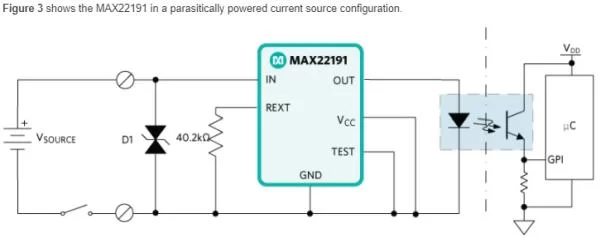A digital input (DI) is a circuit designed to receive a binary signal transmitted from an industrial sensor and translate that input into a reliable logic signal for a programmable logic controller (PLC) or industrial controller.
Common examples of industrial binary signals are pushbuttons and/or temperature or proximity threshold indicators. The MAX22191 parasitically powered DI circuit can monitor Type 1 and Type 3 sink and source binary input signals for PLC and industrial circuits. This application note shows examples of current sink, current source, high voltage, and AC detection digital input circuits using the MAX22191.
Introduction
A DI is a circuit designed to receive a binary signal transmitted from an industrial sensor and translate that input into a reliable logic signal for a PLC or industrial controller. Common examples of industrial binary signals are pushbuttons and/or temperature or proximity threshold indicators. The MAX22191 parasitically powered DI circuit can monitor Type 1 and Type 3 sink and source binary input signals for PLC and industrial circuits.
Types of Digital Inputs
The IEC 61131-2 standard governs the input threshold and current requirements for sinking DI circuits in industrial applications and defines three types of DI circuits for industrial applications:
- Type 1: Electromechanical circuits
- Type 2: Discrete, high current, semiconductor circuits
- Type 3: Integrated (low power) semiconductor circuits
The differences between the DI types are primarily voltage thresholds and current limits. Additionally, DI circuits are typically used in one of two configurations:
Read more: INDUSTRIAL DIGITAL INPUTS WITH THE MAX22191


